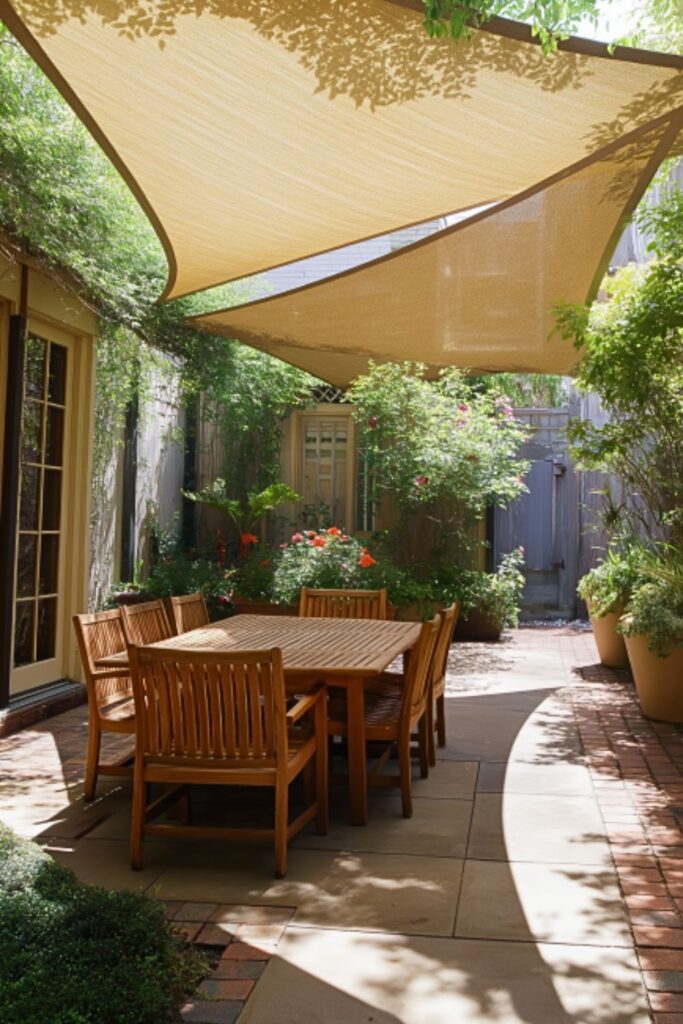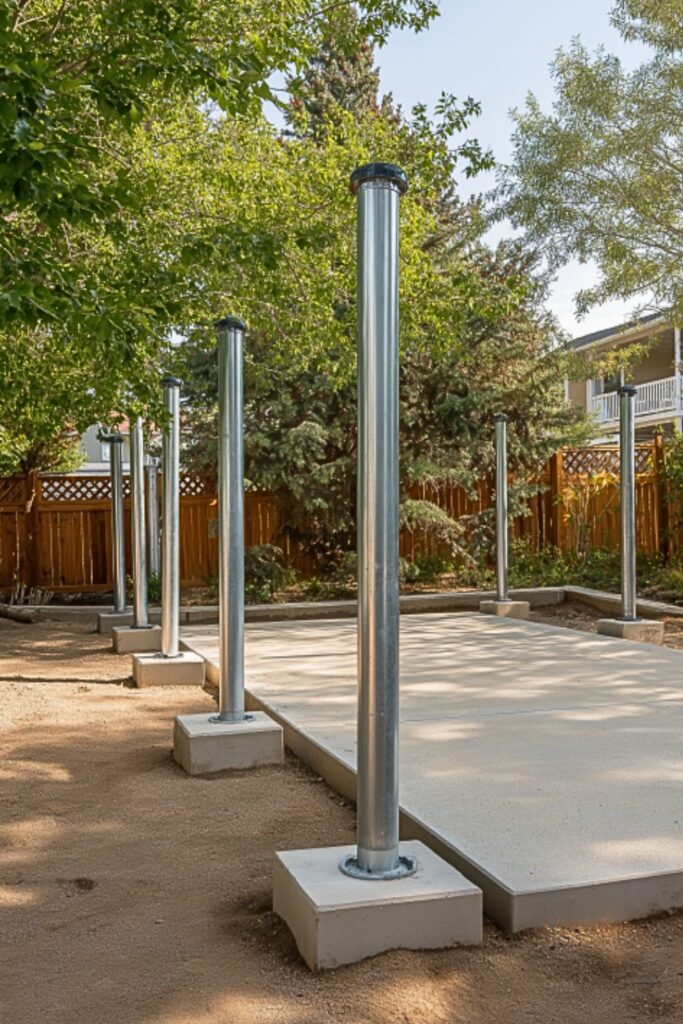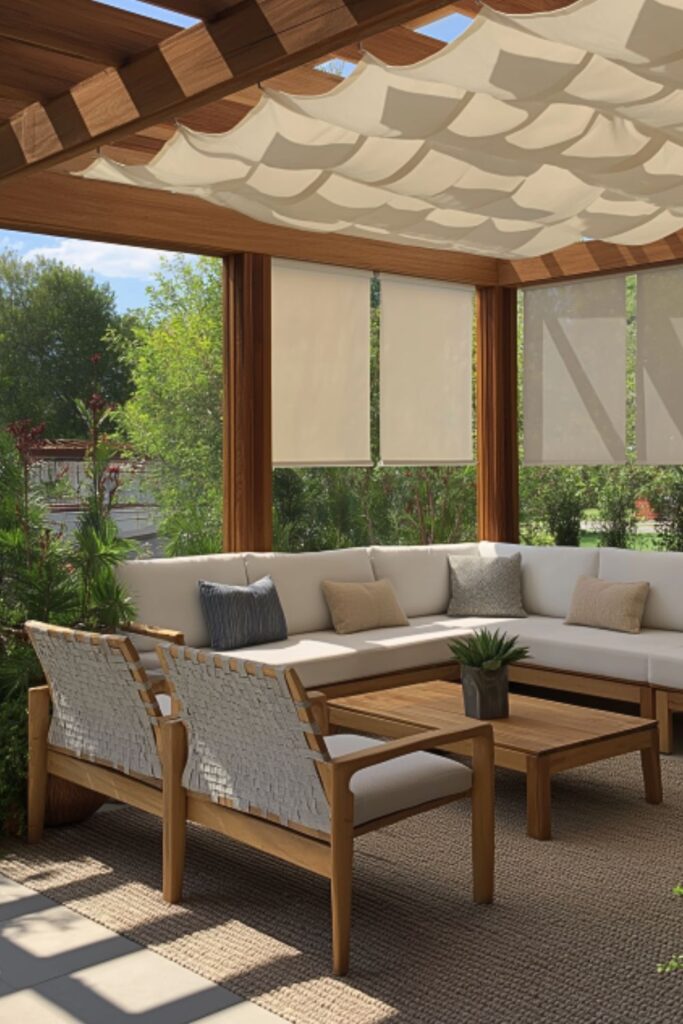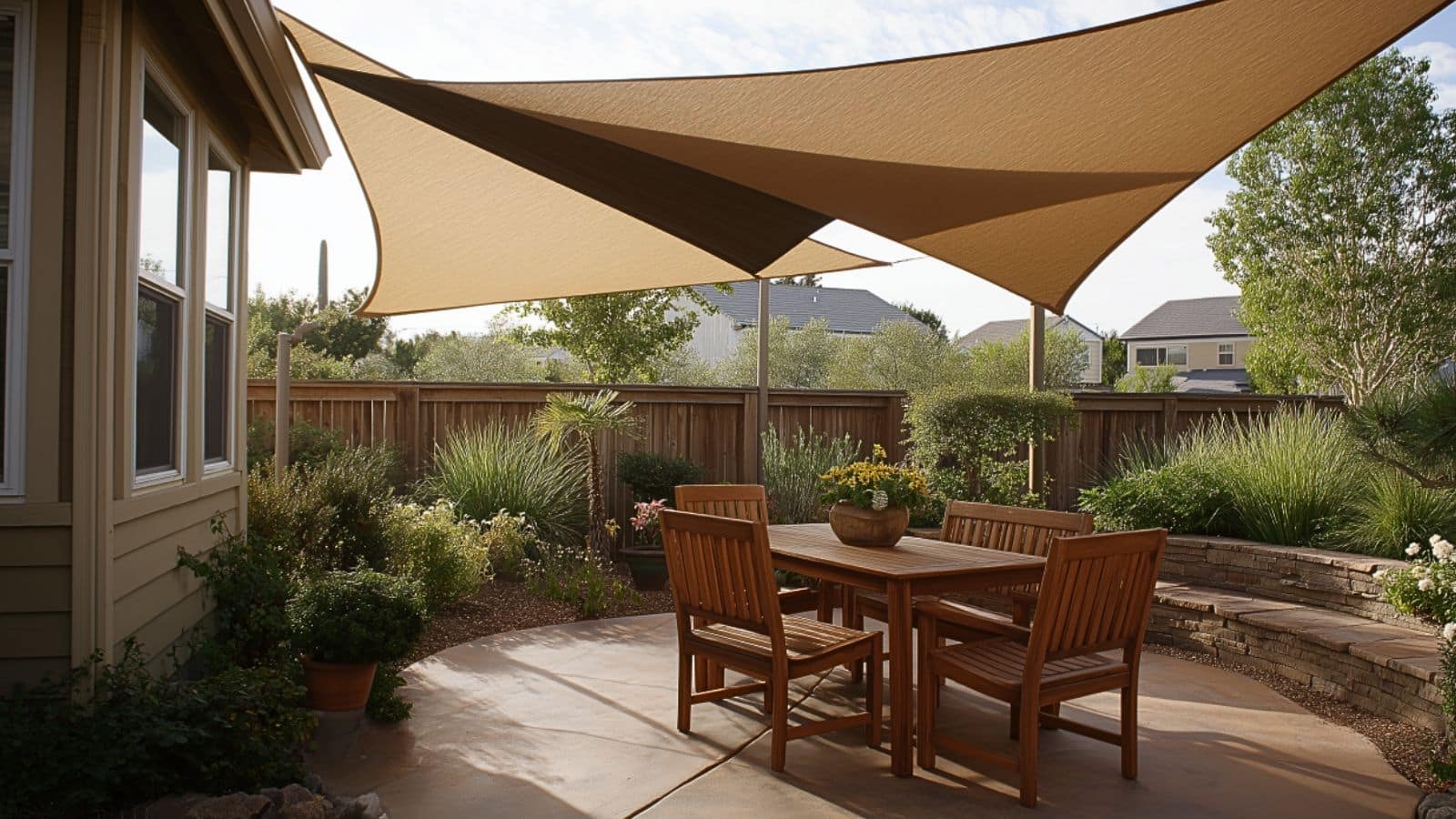DIY Patio Shade Ideas with Shade Sails and Canopies: Stylish Sun Protection Solutions
Table of Contents
Did you know that nearly 50% of homeowners consider shade a top priority for creating functional outdoor spaces? When the sun is intense, a bit of well-designed shade can turn a sweltering patio into a relaxing extension of your home. That’s where DIY patio shade ideas with shade sails and canopies come in—combining eye-catching design with cooling comfort.
Installing shade sails and canopies isn’t just functional—it’s an opportunity to elevate your outdoor aesthetics. Whether you’re aiming for a breezy coastal vibe, a bold modern look, or a laid‑back bohemian retreat, these shade solutions provide flexibility, visual interest, and protection. In this guide, we dive into six inspiring DIY shade ideas—from triangular sails to retractable canopies—with practical tips, tables, and visuals to help you design the perfect backyard setup.
Two in-depth sections explore planning layout and creative styling to ensure your shade feels seamless, stylish, and weather-smart. By the end, you’ll have everything needed to craft a patio that’s cooler, more inviting, and uniquely yours.
Pick the Right Shade Sail Shape and Material

Choosing the right sail shape and fabric sets the stage for performance and style on your patio.
Triangle, Square, or Polygon?
- Triangular sails add drama and simplicity—ideal for corners or low‑ceiling areas.
- Square or rectangular sails create balanced coverage—perfect for dining patios.
- Polygon sails (hexagonal or custom) look sculptural and can cover odd spaces, though installation is more complex.
Fabric Choices for Durability
Look for high-density polyethylene (HDPE) shade cloth—lightweight, UV-resistant, and available in 70–95% blocks. Canvas materials add charm but need treatment. Premium fabrics resist mold, block UV rays, and are breathable.
Color and Opacity Options
Colors range from crisp white to earthy tones like charcoal or tan. Light fabrics reflect heat, while darker shades absorb it—so factor in temperature and style balance.
Shade Sail Comparison Table
| Sail Shape | Best Use | Pros/Cons |
|---|---|---|
| Triangle | Corners, entryways | Easy install, fewer anchors; less coverage |
| Square/Rect. | Dining areas, mid‑patio | Balanced shade; may require tensioning |
| Polygon | Irregular spaces, central patios | Sculptural look; complex setup |
| HDPE Fabric | All‑weather shade sails | Durable, breathable; minimal upkeep |
| Canvas/Treated | Cozy, familiar look | Aesthetic, less UV resistant |
Plan the Layout for Optimal Coverage and Style

Where and how you install shade sails makes all the difference in effectiveness and aesthetics.
Assess Your Sun Patterns
Map sun angles over the day and across seasons. For morning coverage, focus on east-facing shade. For afternoon shade, plan for west or southwest orientation.
Choose Anchor Points Thoughtfully
Secure sails to sturdy structures—mature trees, posts, or house walls. Keep anchors at different heights (e.g., one high, one low) to create visual slope and allow rain runoff.
Space and Tension Requirements
Leave at least a few inches between sail edges and solid structures. Tension ropes or straps with turnbuckles help hold shape and minimize fluttering.
Layout Planning Table
| Step | Task | Considerations |
|---|---|---|
| Sun Mapping | Observe sunlight throughout the day | Use app or paper sketch |
| Anchor Placement | Identify strong walls/trees/posts | Aim for at least 2.5″ sturdy diameter |
| Sail Orientation | Slight slope towards drain direction | Helps with rain, visual interest |
| Tension Devices | Use straps, turnbuckles | Prevents sagging and noise |
Install a Sturdy Support Structure

Securing shade sails and canopies starts with reliable posts or supports — DIY-friendly with a few simple steps.
Choosing Post Material
Go for pressure-treated wood, galvanized steel, or aluminum. Wooden posts can blend with landscaping; metal offers sleek modern appeal.
Proper Post Installation
Pour at least 2‑foot footings with gravel fill and concrete for stability. Ensure posts stand plumb and capped to protect from water damage.
Mounting Hardware Tips
Use marine-grade eye bolts, pad eyes, or anchor plates. These resist rust and hold high tension over time.
Support Structure Table
| Component | Recommendation | Why It Matters |
|---|---|---|
| Post Material | Pressure-treated wood/galv. metal | Blends style; resists weather |
| Footing Depth | 2–3 feet with concrete | Prevents leaning and ensures stability |
| Attention to Level | Posts must be plumb | Ensures even tension on the shade sail |
| Corrosion-Resistant | Stainless marine-grade hardware | Prevents rusting and failure |
Incorporate a Retractable or Fixed Canopy Option
For extra flexibility, canopies give you adjustable shade coverage and weather protection.
Retractable Awnings
Motorized or manually extended fabric awnings attach to the home. They’re ideal for adjustable shade and sun control with a switch or crank.
Pergola-Style Fixed Canopies
Use a wooden pergola frame with vinyl, fabric, or polycarbonate roofing. This adds structure and elegance to your patio.
Roller Shade Systems
Mount roller shades to pergola beams or fascia. These simple options can be opened or closed to filter light or block rain.
Canopy Type Comparison Table
| Canopy Type | Benefits | Considerations |
|---|---|---|
| Retractable Awning | Flexibility, sleek when retracted | Needs wall mounting and clearance |
| Pergola with Canopy | Architectural charm | Fixed structure requires space and build |
| Roller Shades | Budget-friendly and easy to clean | Less protection than sails or awnings |
Choose Stylish Accessories and Lighting
Accents and lighting transform shade features into inviting backyard scenes.
Hang Outdoor String Lights
String lights or globe lighting across sails, pergolas, or tree branches. Warm LED bulbs sparkle beautifully against fabric shades.
Add Planters and Hanging Baskets
Metal planters or ceramic pots on posts add life and color. Hanging baskets with trailing vines soften angles and create layered depth.
Include Cozy Textiles
Outdoor rugs, floor cushions, and throw pillows in complementing colors—blues, grays, ivory—enhance comfort. Choose fabrics rated for UV and mildew resistance.
Outdoor Decor Table
| Accent Element | Recommended Style | Why It Works |
|---|---|---|
| String Lights | Warm LEDs across sails/pergola | Sets ambient evening atmosphere |
| Planters/Baskets | Hanging baskets, ceramic pots | Adds greenery and color |
| Soft Furnishings | UV-safe cushions, cushions, rugs | Functional comfort and visual warmth |
Weatherproofing and Maintenance Tips
A DIY shade project is only as good as its maintenance plan. Keeping everything clean and sturdy ensures longevity.
Clean and Care for Fabrics
Wash sails and awnings in mild soap and water every season. Remove mold quickly with vinegar solution. Rinse thoroughly and let dry fully before storing shawls.
Hardware and Post Maintenance
Tighten eye bolts and straps seasonally. Re-stain wood posts every 2–3 years, recoat steel posts as needed to prevent rust. Replace fabrics showing wear or UV breakdown.
Wind and Snow Considerations
Install sails with some droop to allow wind flow. During heavy snowfall, temporarily remove sails or choose canopy panels designed to shed snow.
Maintenance Checklist Table
| Task | Frequency | Tools or Materials Needed |
|---|---|---|
| Clean Fabric Covers | Twice/year | Mild soap, vinegar, soft brush |
| Inspect Hardware | Quarterly | Wrenches, turnbuckles |
| Re-stain/Recoat Posts | Every 2–3 years | Exterior wood stain or paint/metal coating |
| Seasonal Removal | Winter or storm | Storage bag, tarp, tie-downs |
Creative Shade Sail Styling Ideas
Beyond basics, use creative styling to make your shade area uniquely yours.
Layer Multiple Sail Shapes
Overlapping sails—like a triangle over a rectangle—create sculptural play and layered shading. Offset colors—tan and charcoal, for example—for contrast.
Mix Sail Heights for Flair
Position sails at varying heights to create dynamic lines and rain runoff paths. Visual interest increases as sights shift around patio.
Pair with Greenery Screens
Train vines on trellises or pergola side edges to grow up sail posts. Botanical borders feel cooler and more integrated with nature.
Styling Ideas Table
| Design Technique | How to Implement | Visual Effect |
|---|---|---|
| Multiple Sail Layers | Overlap colors and edges | Sculptural depth and greater coverage |
| Varied Heights | Install posts at different heights | Dynamic shadows and fall rain paths |
| Greenery Integration | Plant vines or use potted plants | Softens edges and cools air |
These styling ideas elevate your shade feature from functional to a design statement.
Conclusion
DIY patio shade projects with shade sails and canopies offer a smart blend of style, comfort, and affordability. Whether you’re crafting crisp triangular sails, a custom pergola canopy, or mixing in airplane lights and planters, these solutions turn outdoor spaces into personal retreats.
With thoughtful planning—from material choices and layout to lighting, styling, and seasonal care—you can enjoy shelter that’s as durable as it is delightful. So grab your tools (or your phone for inspiration), and get ready to design a shaded oasis you’ll love spending time in for years to come.

